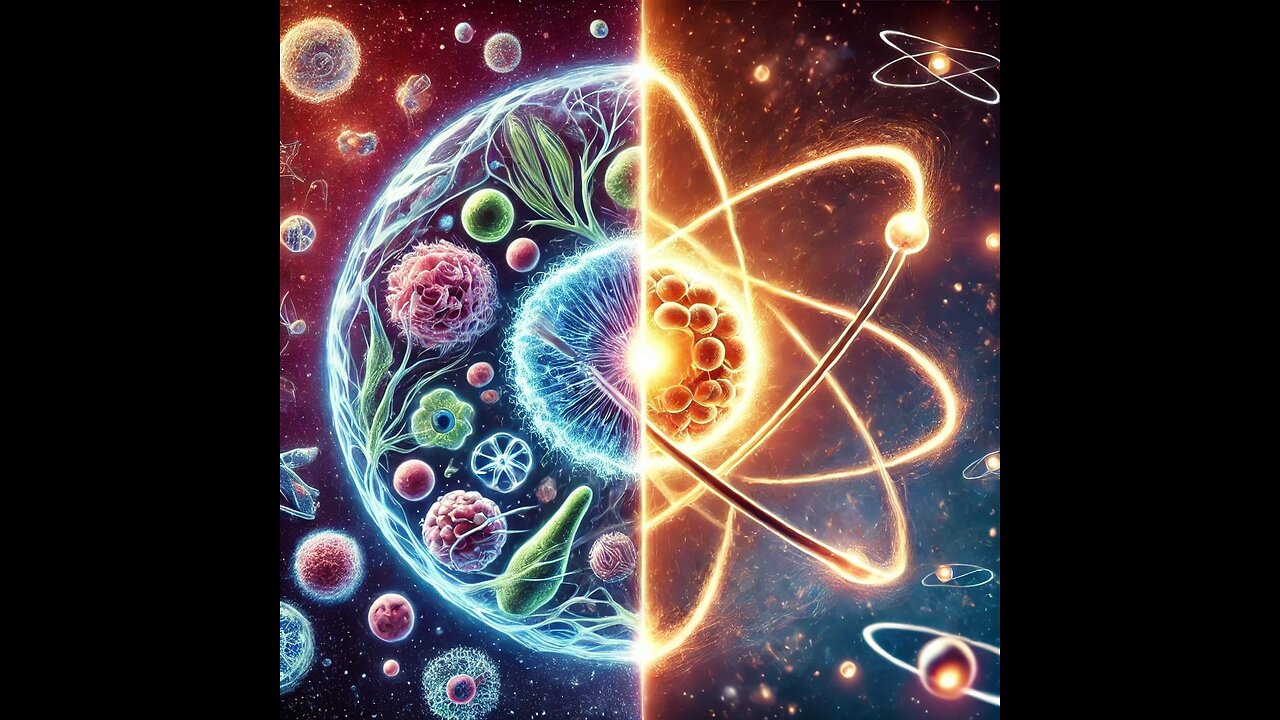Premium Only Content

Convergent Darwinism Eukaryotes vs Atoms ep3
Darwinian Universal is a cosmology and physics theory that aims to provide a comprehensive explanation of the universe's origin and evolution, as well as the fundamental principles governing its behaviour. This theory incorporates elements of natural selection and evolution, as well as concepts from various fields of physics, such as quantum mechanics and general relativity.
The Darwinian Universal theory posits that the universe is a dynamic and evolving system, in which structures and processes emerge and change over time in a manner analogous to biological evolution. This includes the formation of galaxies, stars, planets, atoms and the emergence of life itself.
The theory also proposes that the fundamental constants and laws of physics may not be fixed and unchanging but could have evolved and fine-tuned over time through a process of natural selection. This could potentially explain the apparent fine-tuning of the universe, as well as the emergence of complex structures and phenomena.
The Convergent Themes of Eukaryotes and Atoms: Nucleus, Shells, and Bonding Mechanisms
In the intricate web of life and the vastness of the cosmos, there exists a curious symmetry—a convergence that hints at a deeper connection between the biological and the physical. When we peer into the structure of a eukaryotic cell and compare it to the atom, we begin to see patterns that suggest these two realms, though vastly different in scale and function, may share more than we once imagined.
Eukaryotic cells, the building blocks of complex life, are characterized by their nucleus, surrounded by various organelles, all encased within a membrane. This organization is not unlike that of an atom, where a central nucleus is orbited by electrons in defined shells. These structural similarities might be more than mere coincidence—they could be the result of convergent evolution, driven by an underlying organizational principle that shapes the complexity of the universe.
Around half a billion years ago, eukaryotic cells underwent a transformative evolution, developing bonding mechanisms that allowed for the formation of multicellular organisms. This was a watershed moment in the history of life. Plants evolved cellulose bonds, giving rise to the rigid structures we see in nature, while animals developed collagen bonds, enabling the creation of diverse and adaptable bodies. These independent yet parallel developments illustrate a core theme in Darwinian evolution: the emergence of similar traits in response to common challenges, a process known as convergence.
The first multicellular organisms, such as the sea sponge, marked the beginning of a new era. These early animals, their cells bonded by collagen, set the stage for the incredible diversity of life we see today. Eukaryotic cells, once solitary entities, became part of complex, interdependent systems, each cell specializing in functions that contribute to the whole—skin, blood, organs—all working in harmony.
This journey from single-celled organisms to the complex bodies of multicellular life took billions of years, underscoring the complexity and sophistication of the processes involved. The evolution of cellular bonding mechanisms was not a quick leap, but a gradual, intricate development, highlighting the creative power of natural selection.
Now, let’s turn our attention back to the atom. Despite the Big Bang’s instantaneous origin story, atoms share the same structural and behavioral themes as eukaryotic cells: a central nucleus, surrounded by electron shells, and bonding mechanisms that allow for the formation of molecules—composite bodies of matter. The standard model of cosmology, while immensely powerful in its descriptive capability, stops short of explaining why atoms are structured this way. Why does this theme of a nucleus surrounded by shells recur, both in the microcosm of biology and in the fundamental particles of the universe?
The sophistication of atomic bonding—so critical to the chemistry of life—suggests that there may be a deeper, universal principle at play. If the themes we observe in atoms and cells are the result of convergent evolution, it opens up a fascinating possibility: that the universe itself is subject to an evolutionary process, one that selects for structures and systems that optimize for energy capture and efficiency, whether in a biological cell or in an atom.
Consider this: life on Earth evolved structures like the cell nucleus and membranes to optimize the capture and use of sunlight, the most abundant energy source available. Could atoms, in a similar way, have evolved their own structures to optimize for the capture and utilization of energy from the fabric of space itself? This idea pushes us to think of atomic physics not just as a set of static rules, but as a dynamic, evolving system—one that mirrors the processes we see in biological evolution.
In law, precedents guide decisions, providing a framework for understanding new cases based on past judgments. Science, too, might benefit from this approach. The parallels between cellular biology and atomic structure could serve as a precedent, guiding us toward a new understanding of the universe’s complexity.
In conclusion, the convergent themes we see between eukaryotic cells and atoms challenge us to reconsider the origins of complexity in the universe. By exploring the possibility of a common organizational principle, we may uncover a deeper, more unified theory that explains not just the structure of life, but the very fabric of the cosmos itself.
-
 44:57
44:57
Standpoint with Gabe Groisman
1 day agoWill Byron Donalds Run for Florida Governor? With Congressman Byron Donalds
25.6K6 -
 1:06:25
1:06:25
Savanah Hernandez
3 hours agoEXPOSED: FBI destroys evidence as NSA’s LGBTQ sex chats get leaked?!
42.1K14 -
 1:59:58
1:59:58
Revenge of the Cis
4 hours agoEpisode 1452: Hindsight
37.5K3 -
 1:20:35
1:20:35
Awaken With JP
6 hours agoCrenshaw Threatens to Kill Tucker and Other Wild Happenings - LIES Ep 80
92.4K63 -
 1:32:19
1:32:19
Russell Brand
5 hours agoBREAK BREAD EP. 15 - LECRAE
105K10 -
 1:37:26
1:37:26
The Officer Tatum
6 hours agoLIVE Rachel Maddow, Don Lemon MELTDOWN Over Joy Reid's FIRING! + More Ep 68
68K31 -
 1:11:24
1:11:24
The Gateway Pundit
4 hours agoEpstein & JFK Files BLOCKED: Luna’s SHOCKING Clash with Pam Bondi! | Elijah Schaffer & Jim Hoft
119K40 -
 1:12:42
1:12:42
John Crump Live
8 hours ago $0.45 earnedFake Gun Advocates.
9.06K1 -
![[Ep 616] Colony Ridge History & Raids | Guest: Elsa Kurt | Crenshaw Unhinged – Wants to Kill Tucker](https://1a-1791.com/video/fwe1/4d/s8/1/K/3/M/j/K3Mjy.0kob-small-Ep-616-Colony-Ridge-History.jpg) 2:00:45
2:00:45
The Nunn Report - w/ Dan Nunn
4 hours ago[Ep 616] Colony Ridge History & Raids | Guest: Elsa Kurt | Crenshaw Unhinged – Wants to Kill Tucker
24.2K10 -
 2:03:21
2:03:21
The Quartering
7 hours agoDan Crenshaw Hot Mic Threat, Jake Paul Endorses Vivek, and Kathleen Kennedy Leaves Lucasfilm
76.3K29